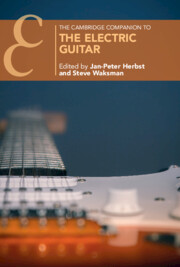Book contents
- The Cambridge Companion to the Electric Guitar
- Cambridge Companions to Music
- The Cambridge Companion to the Electric Guitar
- Copyright page
- Contents
- Figures
- Tables
- Contributors
- 1 Introduction
- Part I History
- Part II Technology and Timbre
- Personal Take II: Ulrich Teuffel
- 5 They Don’t Make ’Em Like They Used To: Electric Guitar Design 1950–2022
- 6 Even in the Quietest Moments: Amplifying the Electric Guitar
- 7 Stompbox Revolution: Electric Guitar Pedals and Tone
- Part III Musical Style and Technique
- Part IV The Electric Guitar in Society
- Part V The Global Instrument
- Index
- References
5 - They Don’t Make ’Em Like They Used To: Electric Guitar Design 1950–2022
from Part II - Technology and Timbre
Published online by Cambridge University Press: 08 November 2024
- The Cambridge Companion to the Electric Guitar
- Cambridge Companions to Music
- The Cambridge Companion to the Electric Guitar
- Copyright page
- Contents
- Figures
- Tables
- Contributors
- 1 Introduction
- Part I History
- Part II Technology and Timbre
- Personal Take II: Ulrich Teuffel
- 5 They Don’t Make ’Em Like They Used To: Electric Guitar Design 1950–2022
- 6 Even in the Quietest Moments: Amplifying the Electric Guitar
- 7 Stompbox Revolution: Electric Guitar Pedals and Tone
- Part III Musical Style and Technique
- Part IV The Electric Guitar in Society
- Part V The Global Instrument
- Index
- References
Summary
Guitar shop showrooms are museums of design. As visitors walk by rows of instruments, they encounter a tactile history of popular music. However, shoppers may notice that the majority of electric guitars available in the modern marketplace are strikingly similar. While there are certainly instances of radically new styles, they are outnumbered by instruments that resemble mid-twentieth century designs, such as the Fender Stratocaster and the Gibson Les Paul. This chapter explores moments in electric guitar design history that speak to marketplace tensions between historical consciousness and innovation. There is a widespread belief that the electric guitar was perfected half a century ago. Therefore, new design choices must be in conversation with the past. Success stories—such as Fender’s Custom Shop series—rely upon such historical nods. Design flops—such as Gibson’s “G-Force” automatic tuner—fail because they innovate beyond what buyers are willing to accept. So, is the electric guitar dead, as some commentators have proclaimed? I argue that the instrument is in a persistent state of rebirth as new models move forwards by looking backwards.
- Type
- Chapter
- Information
- The Cambridge Companion to the Electric Guitar , pp. 76 - 92Publisher: Cambridge University PressPrint publication year: 2024

